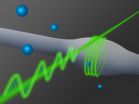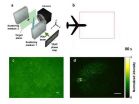(Press-News.org) Using the Very Large Telescope Interferometer (VLTI) in near-infrared light [1], the team of astronomers observed 92 nearby stars to probe exozodiacal light from hot dust close to their habitable zones and combined the new data with earlier observations [2]. Bright exozodiacal light, created by the glowing grains of hot exozodiacal dust, or the reflection of starlight off these grains, was observed around nine of the targeted stars.
From dark clear sites on Earth, zodiacal light looks like a faint diffuse white glow seen in the night sky after the end of twilight, or before dawn. It is created by sunlight reflected off tiny particles and appears to extend up from the vicinity of the Sun. This reflected light is not just observed from Earth but can be observed from everywhere in the Solar System.
The glow being observed in this new study is a much more extreme version of the same phenomenon. While this exozodiacal light — zodiacal light around other star systems — had been previously detected, this is the first large systematic study of this phenomenon around nearby stars.
In contrast to earlier observations the team did not observe dust that will later form into planets, but dust created in collisions between small planets of a few kilometres in size — objects called planetesimals that are similar to the asteroids and comets of the Solar System. Dust of this kind is also the origin of the zodiacal light in the Solar System.
"If we want to study the evolution of Earth-like planets close to the habitable zone, we need to observe the zodiacal dust in this region around other stars," said Steve Ertel, lead author of the paper, from ESO and the University of Grenoble in France. "Detecting and characterising this kind of dust around other stars is a way to study the architecture and evolution of planetary systems."
Detecting faint dust close to the dazzling central star requires high resolution observations with high contrast. Interferometry — combining light collected at the exact same time at several different telescopes — performed in infrared light is, so far, the only technique that allows this kind of system to be discovered and studied.
By using the power of the VLTI and pushing the instrument to its limits in terms of accuracy and efficiency, the team was able to reach a performance level about ten times better than other available instruments in the world.
For each of the stars the team used the 1.8-metre Auxiliary Telescopes to feed light to the VLTI. Where strong exozodical light was present they were able to fully resolve the extended discs of dust, and separate their faint glow from the dominant light of the star [3].
By analysing the properties of the stars surrounded by a disc of exozodiacal dust, the team found that most of the dust was detected around older stars. This result was very surprising and raises some questions for our understanding of planetary systems. Any known dust production caused by collisions of planetesimals should diminish over time, as the number of planetesimals is reduced as they are destroyed.
The sample of observed objects also included 14 stars for which the detection of exoplanets has been reported. All of these planets are in the same region of the system as the dust in the systems showing exozodiacal light. The presence of exozodiacal light in systems with planets may create a problem for further astronomical studies of exoplanets.
Exozodiacal dust emission, even at low levels, makes it significantly harder to detect Earth-like planets with direct imaging. The exozodiacal light detected in this survey is a factor of 1000 times brighter than the zodiacal light seen around the Sun. The number of stars containing zodiacal light at the level of the Solar System is most likely much higher than the numbers found in the survey. These observations are therefore only a first step towards more detailed studies of exozodiacal light.
"The high detection rate found at this bright level suggests that there must be a significant number of systems containing fainter dust, undetectable in our survey, but still much brighter than the Solar System's zodiacal dust," explains Olivier Absil, co-author of the paper, from the University of Liège. "The presence of such dust in so many systems could therefore become an obstacle for future observations, which aim to make direct images of Earth-like exoplanets."
INFORMATION:
Notes
[1] The team used the VLTI visitor instrument PIONIER, which is able to interferometrically connect all four Auxiliary Telescopes or all four Unit Telescopes of the VLT at the Paranal Observatory. This led to not only extremely high resolution of the targets but also allowed for a high observing efficiency.
[2] Previous observations were made with the CHARA array — an optical astronomical interferometer operated by the Center for High Angular Resolution Astronomy (CHARA) of the Georgia State University, and its fibred beam combiner FLUOR.
[3] As a by-product, these observations have also led to the discovery of new, unexpected stellar companions orbiting around some of the most massive stars in the sample. "These new companions suggest that we should revise our current understanding of how many of this type of star are actually double," says Lindsay Marion, lead author of an additional paper dedicated to this complementary work using the same data.
More information
This research was presented in a paper "A near-infrared interferometric survey of debris-disc stars. IV. An unbiased sample of 92 southern stars observed in H-band with VLTI/PIONIER", by S. Ertel et al., to appear in the journal Astronomy & Astrophysics. The complementary paper on companion stars found in the survey is "Searching for faint companions with VLTI/PIONIER. II. 92 main sequence stars from the Exozodi survey", by L. Marion et al., in the same edition of the journal.
The team is composed of S. Ertel (Université Grenoble Alpes, France; ESO, Chile), O. Absil (University of Liège, Belgium), D. Defrère (University of Arizona, USA), J.-B. Le Bouquin (Université Grenoble Alpes), J.-C. Augereau (Université Grenoble Alpes), L. Marion (University of Liège), N. Blind (Max-Planck Institute for Extraterrestrial Physics, Garching, Germany), A. Bonsor (University of Bristol, United Kingdom), G. Bryden (California Institute of Technology, Pasadena, USA), J. Lebreton (California Institute of Technology), and J. Milli (Université Grenoble Alpes)
ESO is the foremost intergovernmental astronomy organisation in Europe and the world's most productive ground-based astronomical observatory by far. It is supported by 15 countries: Austria, Belgium, Brazil, the Czech Republic, Denmark, France, Finland, Germany, Italy, the Netherlands, Portugal, Spain, Sweden, Switzerland and the United Kingdom. ESO carries out an ambitious programme focused on the design, construction and operation of powerful ground-based observing facilities enabling astronomers to make important scientific discoveries. ESO also plays a leading role in promoting and organising cooperation in astronomical research. ESO operates three unique world-class observing sites in Chile: La Silla, Paranal and Chajnantor. At Paranal, ESO operates the Very Large Telescope, the world's most advanced visible-light astronomical observatory and two survey telescopes. VISTA works in the infrared and is the world's largest survey telescope and the VLT Survey Telescope is the largest telescope designed to exclusively survey the skies in visible light. ESO is the European partner of a revolutionary astronomical telescope ALMA, the largest astronomical project in existence. ESO is currently planning the 39-metre European Extremely Large optical/near-infrared Telescope, the E-ELT, which will become "the world's biggest eye on the sky".
Links
Research paper on exozodiacal light: http://www.eso.org/public/archives/releases/sciencepapers/eso1435/eso1435a.pdf
Complementary research paper on stellar companions: http://arxiv.org/abs/1409.6105
Announcement on the PIONIER Instrument: http://www.eso.org/public/announcements/ann1081/
Contacts
Steve Ertel
European Southern Observatory
Santiago, Chile
Email: sertel@eso.org
Lindsay Marion
University of Liège
Liège, Belgium
Tel: +32 4 366 97 58
Cell: +32 472 347 742
Email: lindsay.marion@ulg.ac.be
Jean-Charles Augereau
Institut de Planétologie et d'Astrophysique de Grenoble (IPAG)
Grenoble, France
Tel: +33 (0)4 76 51 47 86
Email: Jean-Charles.Augereau@obs.ujf-grenoble.fr
Richard Hook
ESO education and Public Outreach Department
Garching bei München, Germany
Tel: +49 89 3200 6655
Cell: +49 151 1537 3591
Email: rhook@eso.org
VLTI detects exozodiacal light
New challenge for direct imaging of exo-Earths
2014-11-03
ELSE PRESS RELEASES FROM THIS DATE:
Preterm, low birth-weight babies may need new hips in adulthood
2014-11-03
Researchers from Australia report that low birth weight and preterm birth are linked to increased risk for osteoarthritis (OA)-related hip replacements in adulthood. Findings published in the American College of Rheumatology (ACR) journal, Arthritis Care & Research, indicate that low birth weight and pre-term babies were not at greater risk of knee arthroplasty due to OA as adults.
According to the ACR, 27 million Americans over the age of 25 are diagnosed with clinical OA. Symptoms of OA range from mild to severe and include pain, stiffness, and swelling of joints. ...
March of Dimes calls for 50 percent reduction in preterm births by 2030
2014-11-03
WHITE PLAINS, N.Y., Nov. 3, 2014 – The March of Dimes is calling for a nationwide effort to reduce U.S. preterm births to 5.5 percent of all live births by 2030. Seven other developed countries already have preterm birth rates below 6 percent, and 15 have rates below 7 percent.
The U.S. rate of 11.4 percent in 2013 is one of the highest. The U.S. ranked 37th out of 39 high resource countries in 2010.
"The United States spends more money per capita on health care than almost any other country in the world, and yet our premature birth rate and our infant mortality ...
Study reveals startling decline in European birds
2014-11-03
Bird populations across Europe have experienced sharp declines over the past 30 years, with the majority of losses from the most common species, say the University of Exeter, the RSPB and the Pan-European Common Bird Monitoring Scheme (PECBMS) in a new study. However numbers of some less common birds have risen.
The study, published today in the journal Ecology Letters, reveals a decrease of 421 million individual birds over 30 years. Around 90 percent of these losses were from the 36 most common and widespread species, including house sparrows, skylarks, grey partridges ...
Sea sponge drug could boost advanced breast cancer survival by 5 extra months
2014-11-03
THE cancer drug eribulin, originally developed from sea sponges, could give women with advanced triple negative breast cancer an average of five extra months of life, according to research presented at the National Cancer Research Institute (NCRI) Cancer Conference in Liverpool today (Monday).
Researchers led by Professor Chris Twelves, based at the University of Leeds and Leeds Teaching Hospitals NHS Trust, looked at two major clinical trials of more than 1,800 women with breast cancer that had started to spread to other parts of the body. The phase III trials – ...
The Lancet Diabetes & Endocrinology: Weight loss surgery substantially reduces the risk of developing type 2 diabetes
2014-11-03
Bariatric (weight loss) surgery, such as gastric bypass or gastric banding, could reduce the risk of developing type 2 diabetes by around 80% in obese people, compared with standard care, new research published in The Lancet Diabetes & Endocrinology journal suggests.
Being overweight or obese is the main modifiable risk factor for type 2 diabetes. More than 80% of adults with type 2 diabetes are overweight or obese [1]. In England, just over a quarter of adults (26%) were classified as obese in 2010 (body mass index [BMI] 30kg/m2 or over)[2]. Up to 3% of people with ...
Getting more out of nature: Genetic toolkit finds new maximum for crop yields
2014-11-02
Cold Spring Harbor, NY – Scientists at Cold Spring Harbor Laboratory (CSHL) today announced a new way to dramatically increase crop yields by improving upon Mother Nature's offerings. A team led by Associate Professor Zachary Lippman, in collaboration with Israeli colleagues, has discovered a set of gene variations that can boost fruit production in the tomato plant by as much as 100%.
Plant breeders will be able to combine different gene variants among the set to create an optimal plant architecture for particular varieties and growing conditions. The set of mutations ...
Sediment supply drives floodplain evolution in Amazon Basin
2014-11-02
A new study of the Amazon River basin shows lowland rivers that carry large volumes of sediment meander more across floodplains and create more oxbow lakes than rivers that carry less sediment.
The findings have implication for the Amazonian river system, which may be significantly altered by proposed mega-dams that would disrupt sediment supplies.
Researchers from Cardiff University's School of Earth and Ocean Sciences examined 20 reaches within the Amazon Basin from Landsat imagery spanning nearly 20 years (1985 to 2013).
They found rivers transporting larger amounts ...
Study: 'Wimpy' antibody protects against kidney disease in mice
2014-11-02
CINCINNATI—An antibody abundant in mice and previously thought to offer poor assistance in fighting against infection may actually play a key role in keeping immune responses in check and preventing more serious self-inflicted forms of kidney disease, researchers say.
Led by researchers at the University of Cincinnati (UC) and Cincinnati Children's Hospital Medical Center and published online Nov. 2, 2014, in the journal Nature, the study finds that the mouse antibody IgG1, which is made in large quantities and resembles a human antibody known as IgG4, may actually ...
Two photons strongly coupled by glass fiber
2014-11-02
Two photons in free space do not interact. Light waves can pass through each other without having any influence on each other at all. For many applications in quantum technology, however, interaction between photons is crucial. It is an indispensable prerequisite for transmitting information through tap-proof quantum channels or for building optical logic gates. At the Vienna University of Technology (TU Wien), scientists have now succeeded in establishing a strong interaction between two single photons. This opens up completely new possibilities for quantum optics. The ...
Improving imaging of cancerous tissues by reversing time
2014-11-02
As a child, it was fascinating to put a flashlight up to our palms to see the light shine through the hand. Washington University in St. Louis engineers are using a similar idea to track movement inside the body's tissues to improve imaging of cancerous tissues and to develop potential treatments.
Lihong Wang, PhD, the Gene K. Beare Distinguished Professor of Biomedical Engineering at the School of Engineering & Applied Science is applying a novel time-reversal technology that allows researchers to better focus light in tissue, such as muscles and organs.
Current ...
LAST 30 PRESS RELEASES:
Tracing the quick synthesis of an industrially important catalyst
New software sheds light on cancer’s hidden genetic networks
UT Health San Antonio awarded $3 million in CPRIT grants to bolster cancer research and prevention efforts in South Texas
Third symposium spotlights global challenge of new contaminants in China’s fight against pollution
From straw to soil harmony: International team reveals how biochar supercharges carbon-smart farming
Myeloma: How AI is redrawing the map of cancer care
Manhattan E. Charurat, Ph.D., MHS invested as the Homer and Martha Gudelsky Distinguished Professor in Medicine at the University of Maryland School of Medicine
Insilico Medicine’s Pharma.AI Q4 Winter Launch Recap: Revolutionizing drug discovery with cutting-edge AI innovations, accelerating the path to pharmaceutical superintelligence
Nanoplastics have diet-dependent impacts on digestive system health
Brain neuron death occurs throughout life and increases with age, a natural human protein drug may halt neuron death in Alzheimer’s disease
SPIE and CLP announce the recipients of the 2025 Advanced Photonics Young Innovator Award
Lessons from the Caldor Fire’s Christmas Valley ‘Miracle’
Ant societies rose by trading individual protection for collective power
Research reveals how ancient viral DNA shapes early embryonic development
A molecular gatekeeper that controls protein synthesis
New ‘cloaking device’ concept to shield sensitive tech from magnetic fields
Researchers show impact of mountain building and climate change on alpine biodiversity
Study models the transition from Neanderthals to modern humans in Europe
University of Phoenix College of Doctoral Studies releases white paper on AI-driven skilling to reduce burnout and restore worker autonomy
AIs fail at the game of visual “telephone”
The levers for a sustainable food system
Potential changes in US homelessness by ending federal support for housing first programs
Vulnerability of large language models to prompt injection when providing medical advice
Researchers develop new system for high-energy-density, long-life, multi-electron transfer bromine-based flow batteries
Ending federal support for housing first programs could increase U.S. homelessness by 5% in one year, new JAMA study finds
New research uncovers molecular ‘safety switch’ shielding cancers from immune attack
Bacteria resisting viral infection can still sink carbon to ocean floor
Younger biological age may increase depression risk in older women during COVID-19
Bharat Innovates 2026 National Basecamp Showcases India’s Most Promising Deep-Tech Ventures
Here’s what determines whether your income level rises or falls
[Press-News.org] VLTI detects exozodiacal lightNew challenge for direct imaging of exo-Earths




